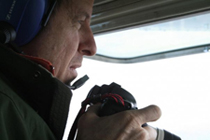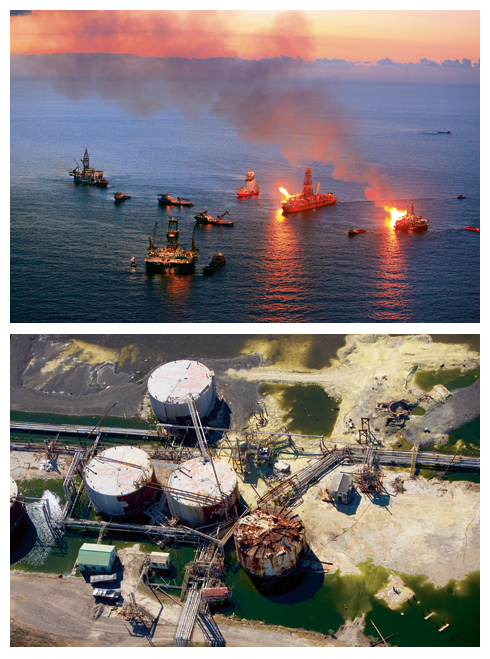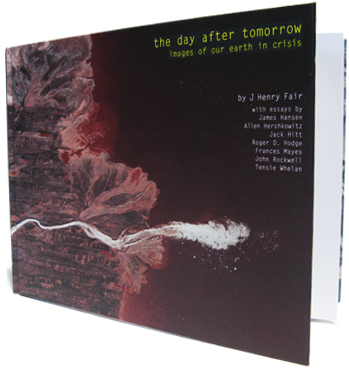
![]()
Artist and environmentalist J Henry Fair documents the industrial detritus that society so willingly overlooks. Focused both on aesthetics and action—he himself describes his work as a “catalyst”—Fair captures scenes that entice and intrigue. His images call on the viewer not only to understand the subject matter, but to explore their own, personal relationship with that subject. Fair’s work is honest and dynamic, as were his reasons for undertaking Industrial Scars, the project that ultimately led to the creation of the day after tomorrow (to be released by powerHouse Books early 2011).
The Industrial Scars project has been under way for over a decade, but to Fair the project has evolved over the course of a lifetime; it is Fair’s response to a society “addicted to petroleum and the unsustainable consumption of other natural resources.” Available early 2011, the day after tomorrow showcases some of Fair’s most beautiful and terrifying images, joined by essays from leading environmentalists, scientists, and authors, including James Hansen, Jack Hit, and Frances Mayes.
pHB: What was it like for you to put together the day after tomorrow, your first book?
HF: With the day after tomorrow, the first big question was: What was the underlying narrative of the book? I talked extensively with my producer, and we ultimately decided that the book’s narrative had to mirror the narrative of the Industrial Scars project, which is about taking a close look at the footprint left behind by our industrial consumer society. As [Industrial Scars] evolved, it became more about looking at and documenting specific issues and trying to create images that would affect the way people thought about those issues. Once we realized that, the narrative of the book became evident, so it’s both a narrative about the evolution of [the Industrial Scars] project, and a narrative about trying to make images that are both pleasing to the viewer and tell a story that the viewer will understand and therefore start questioning the tenets that we base our daily behavior on.
pHB: What do you feel the essays contribute to the book?
HF: There’s a poetic side to these images—the pictures mean different things to different people. It really added something to the book to get the impressions of other artists and scientists. I didn’t really want them to talk about the pictures so much, I wanted them to talk about what brought them to where they are. Why is Allen Hershkowitz a great environmentalist? Why is James Hansen a great environmental scientist? What brought them there, what motivates them to do what they’re doing. And the writers, Jack Hitt, Roger Hodge, Frances Mayes, are some of my favorite writers. What brought them in their lives to this point of sensitivity to what’s happening and what we’re doing?
pHB: Do you ever worry that because these images are so aesthetically beautiful and striking people will look at them, register their beauty, and just leave it at that?
HF: No. The images have to stand on both footings: they have to stand on their aesthetic value or else people wouldn’t stop on them. There certainly are people who will buy the images and not get the message, not change their consumer habits, but I’ve never met anyone who didn’t—after at least contemplating the images—start thinking about the meaning of the images. I really don’t worry that the beauty of the images will obscure the meaning.
pHB: Could you tell us about some future projects that you have in mind?
HF: Well, all of my projects seem to go on forever. One of the things that I’m working on now is documenting the impact of coal ash, which is an unseen menace in our society. We produce 1 billion tons of coal a year and produce 140 million tons of coal ash, and we’ve run out of space to put it so they’re putting it in your sheetrock. Did I mention, by the way, that it’s full of lead, mercury, arsenic, uranium, boron and a bunch of other nasty things? So that’s an ongoing project, and something that I’d like to include in all of these projects—and maybe to become a separate project in itself—would be the faces of people affected by these issues.
There’s a universal phenomenon where the people in these areas affected by these processes raise the alarm, the world finally listens and rushes around and waves their hands, but then doesn’t really do anything. Meanwhile, the people that are down there are still being affected. The faces of these people is a project that I’ve just started and will be developing over the coming years.
powerHouse Books: Can you describe for us the technical considerations that go in to creating such large-scale aerial photographs?
Henry Fair: Originally, I went to a place looking to see what I might find in an industrial area like the Mississippi River Corridor, and hired a small plane and flew up the corridor—they call it Cancer Alley—to see what I might find. There are advantages and disadvantages to a plane vs. a helicopter. A helicopter, of course, lets you position yourself right where you want and snap away, which is really nice. With a plane, on the other hand, you can’t do that, and you only have one fraction of a second in that right spot to get that proper frame and composition. A plane allows you to cover a lot of distance, however, which is an interesting advantage.
pHB: And what do you use as far as camera equipment is concerned?
HF: I started the project on film, but I guess digital is actually at the point where it’s better than film—the reproduction, the straight-line values are better than film, and the ability to adjust color balance or change in light makes it much better. There was a magic of film though that doesn’t exist in digital: Digital is a more mathematical reproduction. Digital also has its failures. One thing I’ve noticed—when shooting a field of bright sulfur, which is as yellow as yellow gets— is that the digital chips fall flat. Clouds and plumes of smoke are also where you very quickly lose detail with digital.
I jump back and forth between wide-angle and telephoto lenses. One thing I am picky about is the optics that I use, whenever possible I like to use nice German optics. Framing these things is quite difficult, because you’re in a bumpy plane, there’s a lot of windage and that pretty much shakes everything. Getting a still, crisp photograph with absolutely no motion blur is a trick. You try to keep the shutter speed over 1000th of a sec, and cry when your favorite frame is blurry.
pHB: Hurricane Katrina provided an intense impetus for the Industrial Scars project, can you talk a little bit about the effect of that catastrophe on your work?
HF: I’ve always been fascinated by the footprint of industrial society—and for that matter, the footprint left behind by any aspect of culture. I’ve always been concerned about the impact that our society has on the natural resources that form our life support system. Probably 11 years ago, I actually went down and figured out that I needed a plane to fly over these things and did it on that lower Mississippi area. That was actually well before Katrina. I had let the project fallow for a couple of years—on account of other projects, and the time just wasn’t right. Katrina devastated New Orleans, the lower Mississippi area, and the whole Gulf Coast, which is a region I quite love, being from the South. I decided around Christmas right after Katrina that I wanted to go and see what the impact was of the storm both on New Orleans and on the industrial areas I had already documented. And that’s what I did. The day after Christmas, 2007, I flew up and down the industrial corridor. At that time I had a better idea of the different things I was looking at, the bauxite waste [a byproduct of aluminum production] or the phosphogypsum stacks from the manufacture of phosphate fertilizer. Katrina was the impetus to resume the [Industrial Scars] project. The pictures I got then were better than those I had gotten before, because I had a better idea of what I was looking for, and the impact of the storm on these industrial systems was spectacular. So that’s the sequence of events, the re-inauguration of the project.
pHB: What kind of momentum did the Gulf of Mexico disaster add to the Industrial Scars project?
HF: When the Macondo Well blew out—the BP deep-water as we know it—I was getting on a plane to Europe and couldn’t rush right down there. I was dismayed about that, and when I came back from Europe it was a month in to [the disaster]. Obviously, I was drawn to it, but I’m not really a disaster photographer. I don’t do disasters, I do processes. I decided I had to go look anyway—I’ve got family and friends down there—and I wondered if I could do anything that hadn’t been done. Of course, every media outlet had been there and done that, and the question of whether I could make any images that hadn’t been made was big in my mind. I decided I had to try.
I was hesitant to use [the Gulf disaster] as the intro to the day after tomorrow, precisely because people are tired of hearing about it. Nonetheless, the impact is just starting to be felt and won’t be known for years. I think that all of that submerged oil that was dissolved in the Gulf by the dispersants that were sprayed will circulate in the world’s ocean systems, and will have a large effect in years to come. And of course it will have a tremendous effect on the Gulf Coast with the aerial spraying of the dispersant.




